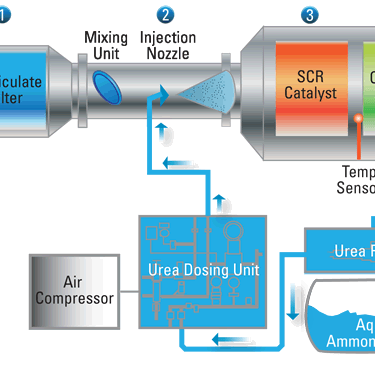SCR NOx Conversion Efficiency low
2/15/20252 min read


Troubleshooting Low SCR NOx Conversion Efficiency
Selective Catalytic Reduction (SCR) systems have become a mainstay in reducing nitrogen oxides (NOx) emissions in diesel engines, improving air quality and meeting stringent environmental regulations. However, sometimes these systems may underperform, resulting in low NOx conversion efficiency. Let's delve into why this happens and how you can address it.
Understanding SCR NOx Conversion Efficiency
SCR technology involves injecting a reductant, typically a urea solution known as Diesel Exhaust Fluid (DEF), into the exhaust stream. The DEF reacts with NOx emissions over a catalyst, converting them into harmless nitrogen (N2) and water (H2O). The efficiency of this conversion process is critical for compliance with emissions standards.
A typical SCR system should achieve a NOx conversion efficiency of 70% or higher. When efficiency drops below this level, it can trigger fault codes, engine derate, or even lead to compliance violations.
Common Causes of Low SCR NOx Conversion Efficiency
Inadequate DEF Quality or Quantity:
Poor quality DEF can result in insufficient NOx reduction. Always ensure you're using high-quality DEF that meets ISO 22241 specifications.
Low DEF levels can cause the system to malfunction. Regularly check and maintain adequate DEF levels.
Catalyst Deterioration:
Over time, the catalyst in the SCR system can degrade due to thermal stress, poisoning, or contamination. Regular maintenance and inspections are crucial for identifying and replacing worn-out catalysts.
Faulty DEF Dosing System:
Issues with the DEF dosing system, such as blocked injectors, pump failures, or faulty sensors, can impede the precise delivery of DEF into the exhaust stream. Troubleshoot and repair any defects in the dosing system.
Exhaust Temperature:
The SCR system operates optimally within a specific temperature range. If the exhaust temperature is too low, it can hinder the NOx conversion process. Ensure the engine is operating at the correct temperature for efficient SCR performance.
Software or Calibration Issues:
Sometimes, the engine control module (ECM) may have outdated software or incorrect calibrations. Updating the ECM software and ensuring proper calibration can resolve efficiency issues.
Troubleshooting and Improving Efficiency
Regular Maintenance:
Adhering to a routine maintenance schedule helps identify and address potential issues before they escalate. Regularly inspect the DEF tank, dosing system, and catalyst for any signs of wear or contamination.
Monitor DEF Quality:
Use a refractometer to test the DEF quality and ensure it meets the required specifications. Replace any DEF that does not meet standards.
Temperature Management:
Monitor and maintain optimal exhaust temperatures to ensure efficient NOx conversion. If the engine is frequently operating at low temperatures, consider installing exhaust insulation or an auxiliary heater.
Professional Diagnostics:
Utilize professional diagnostic tools to scan for fault codes and conduct thorough system checks. Address any detected issues promptly to restore efficiency.
Conclusion
Low SCR NOx conversion efficiency can be a challenge, but with proactive maintenance and timely troubleshooting, you can keep your SCR system running smoothly. By understanding the common causes and implementing effective solutions, you ensure not only compliance with emissions regulations but also the longevity and performance of your diesel engine.
Remember, a well-maintained SCR system not only benefits your engine but also contributes to a cleaner, healthier environment.
Support
Ask questions and share truck repair tips.
Connect
© 2025. All rights reserved.
